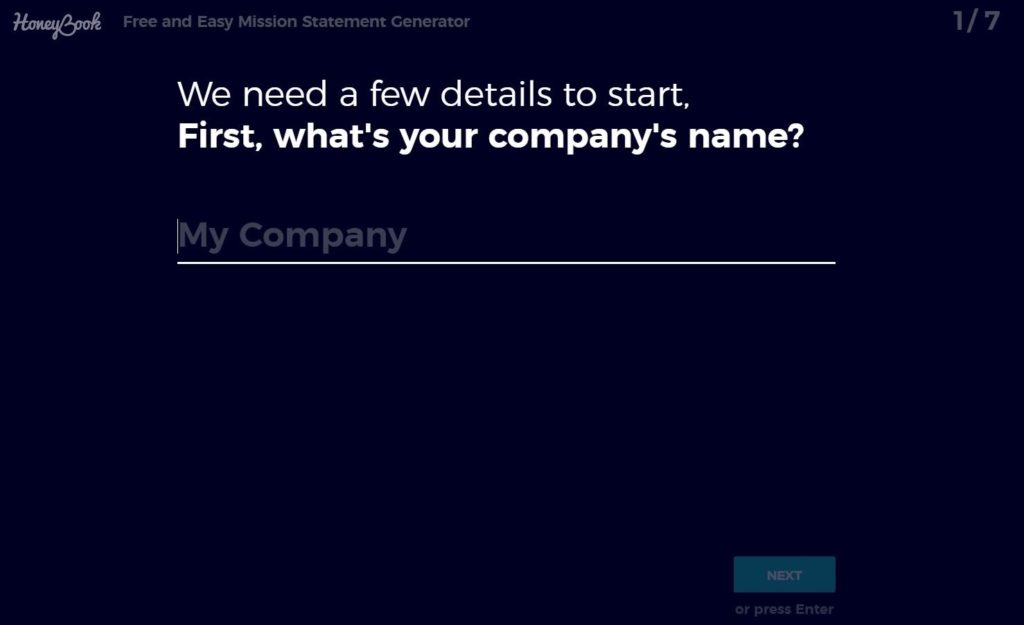Running a successful business involves careful planning and focus. Part of the process includes setting goals and determining a clear-cut purpose.
Two elements critical in defining your business objectives are your vision statement and mission statement. These documents state and summarize your short-term and long-term goals, which is also why the lines get blurry with them.
Each statement serves a different purpose: a mission statement describes what a company wants to do now; a vision statement outlines what it wants to do in the future.
Let’s dive deeper into vision and mission statements to understand why they’re crucial for your business and discuss how you can create these documents for your own business.
What Are Vision and Mission Statements?
Before decoding the similarities and differences, let’s define each of them further.
What is a Vision Statement?
A vision statement is a brief, clear, and definitive description of a company‘s aspirations and the kind of impact it aims to create. Think of it as a guiding beacon that tells people within the organization what the business wants to accomplish and what will happen once they achieve that vision.
It helps facilitate internal decision-making and determines the intended direction of the organization. You can also use it to describe the future of the business while simultaneously emphasizing its overall purpose.
To put things into perspective, a vision statement tells you what you want to become and then gives you a sense of direction to achieve it.
- What are your hopes and dreams and goals for your business?
- Are there any problems your business can solve for the greater good?
- What kind of change are you trying to bring?
As you may have realized, vision statements are future-oriented. But because it has a direct and transcendent nature, they are written in the present tense. It tries to encapsulate the strategic goals for a company and informs everyone what the company values most.
What is a Mission Statement?
A mission statement explains an organization’s core objectives, values, and aims concisely and descriptively. It’s a declaration that defines the daily activities of an organization and how every person working within it will contribute to that overall mission.
The primary purpose of a mission statement is to drive a company toward its goals. In addition to outlining what you do and the core components of your business, it tries to clarify objectives and how you can fulfill them. The idea here is to motivate and inspire a team to consistently advance toward a common goal.
Consider the following questions when writing your mission statement:
- What do you do?
- Who do you do it for?
- How do you serve them?
A mission statement is affirmative, so they typically start with “We provide…” or “We offer…“. You can also use it as a performance standard to help employees make better decisions.
The Basics of Vision and Mission Statements
This section will detail the basics—differences, similarities, and other nuances—of vision and mission statements. Knowing this will help you better understand what goes into making a good vision and mission statement.
Vision Statement vs. Mission Statement
Vision and mission statements are essential documents with different objectives.
A vision statement outlines what you want to become and how you want to impact society and its people. Whereas a mission statement is more present-focused and summarizes the primary goals, purposes, and values of an organization.
Put simply, a mission statement speaks to today, while a vision statement speaks to the future. Let’s take a look at Google‘s vision and mission statements to highlight this difference.
The company‘s vision statement is: “To provide access to the world’s information in one click.”
Despite being short and to the point, Google effectively puts forward its ambitious long-term aspiration to provide people with the world’s information as quickly and efficiently as possible (“in one click”).
On the other hand, Google’s mission statement is: “To organize the world’s information and make it universally accessible and useful.”
This statement aims to guide the company’s daily operations and inform everyone that Google’s primary job is to organize information to make it accessible and useful. Notice how it also complements the vision statement.
As you can see, while the vision statement is aspirational and more focused on the “why,” the mission statement is actionable and outlines the “what” and “how.” That’s how the documents differ from each other.
Collaborative Working
Companies need vision and mission statements to define their purpose and stand out from their competitors. But before they develop them, they must know and be able to articulate their long-term and short-term objectives.
Both documents work together to keep a company focused on meeting pre-established goals and play a significant role in strategic planning.
Every component of a vision and mission statement encourages involved parties to take productive efforts to boost efficiency while simultaneously aligning them to work toward achieving the same purpose. They also help attract the right talent, create an appropriate work culture, and increase productivity levels to achieve success.
On the contrary, a poorly written vision and mission statement present various challenges and setbacks. It’s because they lack detailed insights that are otherwise necessary to guide employees during operations and decision-making.
Drafting A Vision Statement
As a vision statement is your end goal, you must clearly lay out your vision of the future you’re trying to build. It’s also why it makes sense to write your vision statement before your mission statement.
To write a vision statement, start by revisiting the different components of your business or marketing plan, including your elevator pitch, business goals, company values, SWOT analysis, business story, and brand identity.
Once you have it all together, distill everything into one sentence to create the vision statement and show the world what your company is working toward.
Fitting everything in a single line is going to be difficult, but it isn’t impossible. A good way to start is by answering the following questions:
- What is the ultimate purpose of your business?
- What kind of problems do you want to solve through your product or service?
- How does your business aim to make the world better?
- How would you describe your hopes and dreams for the business’s impact?
- What change do you inspire to bring?
Next, work on distilling your answers down to the essentials. Remember, use clear language and concrete wording—similar to an elevator pitch.
The thought process is similar when writing a mission statement.
Drafting A Mission Statement
A mission statement is the core of all your operations that lists everything you must do to reach your vision—which you established in your vision statement. When done right, this document can become the driving force for your company, giving your team a common goal.
Essentially, your mission statement should define your plan of attack, drawing the route to your destination. To do this, consider the following:
- What conditions must be met to make your vision a reality?
- What do you have to do in your day-to-day to fulfill those conditions?
- Who do you serve, and how do you do it?
- How does your business help to make your vision real for your customers?
If you find it difficult to answer these questions, go through your target audience and buyer personas, buying cycle, and so on. Once that’s done, condense all your answers down into a single strong statement.
Again, cut out any jargon and use simple, meaningful language. The mission statement should be one to three sentences maximum, and never more than 100 words. Ideally, the shorter the better.
3 Tools to Improve Your Vision and Mission Statement
Since vision and mission statements answer crucial questions—why, how, and what—these documents are also a crucial component of your business plan. Read on as we discuss some of the best tools you can use to improve these documents.
Market and Vision Statement Templates
The internet is filled with vision and mission worksheet templates. All you need to do is answer various questions to discover details related to your business and then structure the answers to create the documents.
Take a look at Smartsheet’s mission statement template, for instance. It has two columns that explain what you need to consider and then an empty column to jot down answers—pretty straightforward, making it easier for you to create an effective one.

Vision and Mission Statement Generators
Vision and mission statement generators are tools designed to provide you with the necessary assistance to write good statements. However, most of them can’t produce truly useful statements because they don’t have the relevant information.
HoneyBook generator is one such tool.

While they cannot capture the true essence of how unique your vision and mission statement should be, they aren’t entirely useless. You can use these generators to get a better understanding of the tone and wording of these documents. Plus, use it for inspiration to get out of your head and see some new ideas that may spark something for you.
Business Plan Services
Remember how I mentioned a vision statement and mission statement are a vital part of a business plan? This is why online business plan services like LivePlan and Bizplan offer services to write these documents.

These services are similar to business plan software. The only difference is that they offer business and legal specialists who can help you gain a better understanding of the more complex aspects of your business, which, in turn, will make it easier for you to draft your vision and mission statements.
5 Tricks for Writing a Good Vision and Mission Statement
Let’s take a look at a few vision and mission statements best practices to help you create amazing ones for your business.
Clearly Define Your Future
Set up a meeting with your team and ask everyone to define the perfect state of being for your organization—why the company exists and its purpose. Write it down and find words that truly articulate your future goals and plans.
Remain in Sync
Ensure your vision and mission statements are in sync and connected by using words that resonate with your employees as well as third parties. It’s best to write your vision statement first and then use it as a guide when writing your mission statement.
Make Them Memorable and Achievable
Your vision and mission should be a stretch but always within reach. Draft them in a way that makes them to the point and easy to remember. Try to think of something that gives the reader goosebumps and encourages them to take immediate action without making them sound impossible or fanciful.
Align Them With Your Goals
Although this goes without saying, make sure you write statements that align with your goals. Whenever you change your goals and objectives, revisit your vision and mission and make the necessary changes. You may find yourself tweaking your mission statement more often than your vision statement.
Think About the Future
Imagining your future five or ten years down the line is particularly important for your vision statement. But knowing your end goal will also help you draft a better mission statement to outline what steps you should take immediately to get there.
I highly recommend conducting a gap analysis to compare current performance to desired performance. The end result will give you a better understanding of how or where your organization is struggling—and where there are opportunities to grow.
What to Do Next
After writing your vision and mission statement, your next step should focus on developing specific objectives to help you achieve your mission and vision. These objectives include specific measurable results, fulfilling which will help you accomplish your broad goals.
Create an action plan or a business plan that details how you plan on implementing the strategies and what actionable steps you’ll take to bring about changes in all the relevant sectors.
You can read these Quicksprout blogs to get a better understanding of how to go about things:

